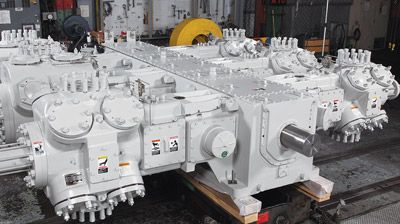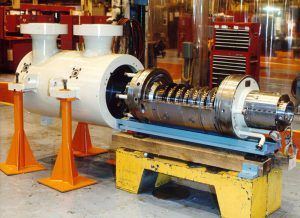Centrifugal vs reciprocating compressor
Choosing between reciprocating and centrifugal compressor for an application depends on a host of operating conditions. These conditions range from maximum discharge pressure and temperature to efficiency and cost. The operator must carefully evaluate site conditions of the application before making a choice.
Excerpts are from the paper “What’s correct for my application: A centrifugal or reciprocating compressor” by Paul Gallick of Elliott Company and Greg Phillippi and Benjamin Williams of Ariel Corporation presented at the 2005 Turbomachinery Symposium in Houston, Texas.


Reciprocating and centrifugal compressors of Dresser-Rand[/caption]
The “typical” reciprocating compressor is used for discharge pressures up to 12,000 psi (828 bar). Special compressors (called hypercompressors) are used in low-density polyethylene production and discharge at pressures up to 50,000 psi (3500 bar). Discharge pressures to 1450 psi (100 bar) for horizontally split centrifugal compressors. Discharge pressures up to 15,000 psi (1034 bar) for radially split (barrel) compressors.
Reciprocating—Can be applied with suction pressures at atmospheric or even a slight vacuum. In vacuum applications, precautions must be taken to prevent atmospheric air from leaking into the cylinder through the piston rod packing. Centrifugal—Inlet pressures to atmospheric or below. For subatmospheric inlet conditions, special seal and buffering designs are employed to keep atmospheric air from being drawn into the compressor.
Maximum Flow • Reciprocating—Reciprocating compressors are positive displacement type compressors. Capacity is limited by cylinder size, the number of throws available, and the available driver speeds. A “throw” is a location on the crankcase where a compressor cylinder can be attached. • Centrifugal—Centrifugal compressors can be sized for an inlet flow of 400,000 acfm (680,000 m3/hr) in a single body. The maximum flow through a centrifugal compressor is limited by the choke point, which is the point at which the flow through some part of the compressor nears a velocity of Mach 1.
Minimum Flow • Reciprocating—Similar to the maximum flow, the minimum flow in a reciprocating compressor is limited by cylinder size, stroke, and speed. Very small reciprocating compressors are available. • Centrifugal—Centrifugal compressors can be sized for flow as low as a few hundred acfm. Unlike a reciprocating compressor where minimum flow is solely a function of compressor geometry and speed, the minimum flow for a centrifugal compressor is limited by an aerodynamic condition known as surge, which is a function of compressor geometry, speed, aerodynamic gas conditions, and system resistance.
Flow Range • Reciprocating—Reciprocating compressors have the ability to change flow (throughput) through speed control, the addition of fixed clearance to a cylinder (fixed or variable volume clearance pockets), cylinder end deactivation, and system recycle. Typical flow range might be 100 percent down to as low as 20 percent, and even lower.
Compressed Gas Molecular Weight • Reciprocating—A reciprocating compressor has no limit with regard to molecular weight. Very light and very heavy gases are compressed equally well. Over the range of molecular weight different application configurations may be required. For example, very low molecular weight gases may present some seal challenges and very high molecular weight gases pose issues with efficiency. But nonetheless, the recip handles the whole range quite well. • Centrifugal—Compression ratio is highly dependent on molecular weight. Head is developed by increasing gas velocity to create kinetic energy and then converting the kinetic energy to pressure in the diffuser. The amount of kinetic energy is a function of gas velocity and mass or molecular weight. Centrifugal compressors are used for a broad range of molecular weight including low molecular weight applications such as hydrogen recycle and high molecular weight applications using refrigerant gases with molecular weights over 100.
Compression Ratio • Reciprocating—The maximum compression ratio that a reciprocating can handle in one stage is limited mostly by compressed gas discharge temperature. The piston rod load generated by the compression ratio may also be a limit. Typical compression ratios are 1.2 to 4.0. • Centrifugal—Compression ratio is a function of gas molecular weight,compressibility,stage geometry,compressor speed,and the number of compressor stages. For a specific gas, the limits to compression ratio are the mechanical and rotordynamic limitations on speed and the number of stages that can be accommodated in a single body. Discharge temperatures resulting from high compression ratios can usually be controlled by intercooling.
Efficiency • Reciprocating—Reciprocating compressors have a very characteristic adiabatic efficiency curve (Figure 8). As compression ratio drops, adiabatic efficiency drops. Efficiency changes with molecular weight. Efficiency will also vary with several other factors, most significantly the compressor cylinder’s ratio of valve flow area to main bore diameter and piston speed.
Reciprocating Compressor Efficiency. • Centrifugal—Polytropic efficiency is typically used for centrifugal compressors rather than adiabatic. Adiabatic is commonly used for air compressors. Typical polytropic efficiencies range from 70 percent to 85 percent. Efficiencies approaching 90 percent are possible. In a centrifugal compressor, efficiency is primarily affected by the internal leakage and mechanical losses.
Cost: Capital and Operating • Reciprocating—Generally a reciprocating compressor will have a lower capital cost since centrifugals use complex geometry parts but recips have a higher operating cost compared to a centrifugal. A centrifugal compressor has fewer wearing parts, resulting in lower operating costs in terms of replacement parts, repairs, and downtime.